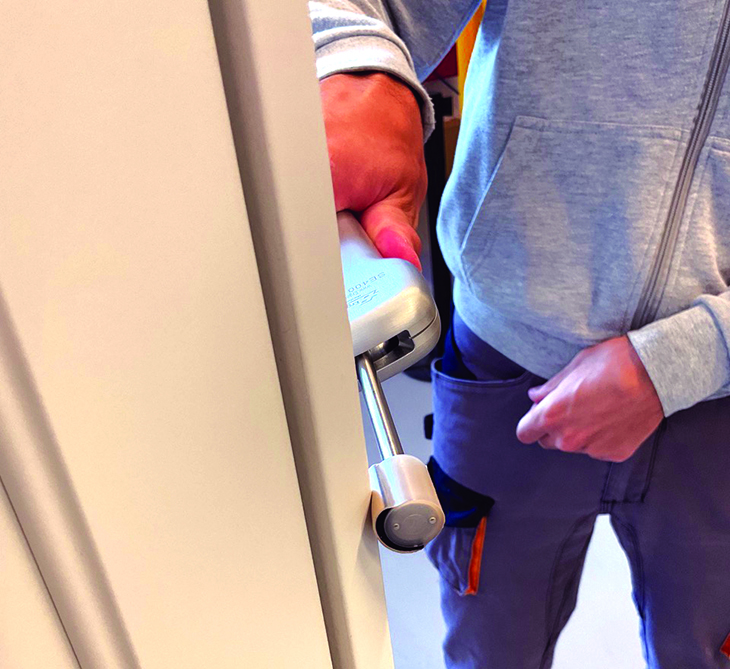Underestimated danger: Sharp edges

Functionality and aesthetics: these are the main requirements for a piece of furniture. Unfortunately, we are not always talking about furniture that has been made in a workman-like manner or, at least, made with the utmost attention to the danger, however small, that even the smallest of its components can create.
One can, for example, make the mistake of underestimating the presence of a hole in which a finger could get stuck, rather than the presence of heavy elements or moving parts that could even cause the crushing of a person or part of his body.
Even edges, if not properly rounded, can cause scratches, abrasions and even deep cuts. Children and the elderly are, of course, the most likely victims; but adults can also experience similar unpleasantness.
Safety has always been one of the main focuses of standardisation and the subject of “sharp edges” is dealt with in all European standard documents concerning furniture, whether for domestic use (EN 14749) or for non-domestic use, or for office storage and community places (EN 16121).
These standards require that all “accessible” parts of a piece of furniture, with which a person may come into contact, must have rounded edges and vertices.
Measuring safety
It is necessary to verify that this potentially dangerous situation does not exist, but the standard does not indicate how to “measure” it, to avoid assessments that are little more than subjective.
On this front Catas – the Italian testing, analysis and certification laboratory for the wood and furniture industry in Europe – has always deployed the experience of its technicians who, in addition to participating in the tables where these standards are defined, compare themselves daily with other institutes in Europe and around the world, so that they can objectively align their assessments.
In recent years, Catas has decided to conduct a study to define an objective system for assessing and measuring the risk of injures that a “sharp edge” can create, moving on two levels: people’s perception of the danger, and the validation of a laboratory instrument that can objectively measure whether an edge is sharp and how much.
The tests carried out firstly established that most people consider edges and vertices of panels with a radius of curvature of less than 0.6-mm to be “sharp”. It should be noted that in industrial edge banding processes, “edge scrapers” are generally not activated in the presence of edges up to 0.5-mm or 0.6-mm thick.
The second part of the project involved the laboratory implementation of an instrument that emulates a person’s finger, an “artificial finger” equipped with a spring system that allows to apply a known force to an evaluation pad that simulates human skin.
By sliding this “roll” over the edge of a piece of furniture – exactly as if it were the finger of a hand – it is possible to detect whether the furniture is dangerous. In a word, whether it cuts our “false finger”.
The comparison between the two phases of this research made it possible to establish a precise correlation between the values collected, demonstrating how the instrument developed by Catas gives a “measure” of the actual danger of an edge, providing laboratory technicians with a way of assessing an edge or a vertex of furniture by applying a reliable, objective, repeatable and reproducible criterion.
For more information, write to Serena Petaccia at petaccia@catas.com.
Comments

- ‘Red gazelle’ makes window installation easy
- Felder’s solutions for window and door production
- Versatile sliding-folding systems from Hafele
- Door line automation from Woodtech Consultants
- Accutec solutions for uPVC windows
- Jowat’s VOC-free primer for window profile wrapping
- Flexible solutions for doors, windows from SCM
- Tostem introduces Giesta steel doors; calls for dealers
- Folder system by Salice optimises cabinet space
- Turakhia has top-quality veneers for doors
- Mirka has solutions for difficult sanding of doors
- When Lamello’s Cabineo became a game changer
- Digital lacquer embossing for flooring from Hymmen
- Weber sanders help achieve luxury surfaces
- Rehau has designs on growing edge band market
- Samet ties up with Greenply to tap Indian hardware market
- IMA Schelling sets up base in India
- Hettich earns BIS nod for hinges, runners
- Biesse India now a Multi-Material Expert
- The importance of selecting the correct tools
- Indian cabinet maker shines at Lyon WorldSkills
- ‘Collaboration holds the key to success’
- Fibreboard recycling becomes a reality
- MumbaiWood now a recognised destination
- Knock on wood: A bouquet of training courses!
- Ligna 2025: ‘Thinking in circles’
- CIFF-Shanghai focuses on furniture design
- Felder hosts in-house show, Technology Days
- Interzum Forum Italy makes impressive debut
- Koelnmesse ties up for 3-in-1 Jakarta fair
- WOFX: a global hub for innovation and growth
- Events Calendar: industry fairs you must visit
- 3D is printing sustainable housing solutions
- Hard or soft? Researchers discover new wood type
- Master, apprentices take AHEC’s cherry challenge
- ‘Zero-to-launch’ modularity transforming hospitality
- ICA’s Urban Matter is about satin-finish metal effect
- MTC’s ‘Woven timbers’ create waves
- Impact of material in interior design
- Underestimated danger: Sharp edges
- Playing safe on clothing storage units
- ‘Green’, 3D-printed panel floors it!
- Adhesive-free joining of wood, metal
- Energy-efficient manufacturing of fibre-based products
- Rice bran wax: a sustainable alternative
- Dual-side hand sanding block has unique features
- Bio-based products for sustainable development
- ‘Wood Vaulting’ may enhance CO2 sequestration
- Protecting forests through advanced AI
- Forest certification benefits wildlife too!
- Elizure, the Rolls Royce of laminates!
- Rehau unveils new Rauvisio Riviera collection
- Hawa Concepta III: upgrade to seamless functional doors
- Hafele’s RE-Twist locks in on security
- Optimus machines feature tomorrow’s technology today
- Merino unveils cutting-edge offerings
- Ornare launches new premium laminates
- New nesting models from SCM
- Advanced moulder, membrane press from Woodtech
- Greenlam Laminates unveils exclusive display centre in Pune
- EUDR implementation dates may be deferred
- Herman Miller introduces bamboo upholstery
- Altendorf named ‘Brand of the Century’
- Catas to verify its test reports
- Combilift wins two prestigious awards
- Holz-Her management transition
- Replica of the Oval Office opens
- Ozone Blu sets up experience centre
- SCM opens new subsidiary in Slovenia
- VDMA faces business stagnation
- RentoMojo reports strong growth in FY24
- Century Plyboards on expansion mode
- Subhra named DG of FSC
- Meta to assist Skill India Mission
- Sugatsune opens Bengaluru experience centre
- Dieffenbacher acquires Pagnoni
- Pepperfry partners with Infra.Market
- Hafele opens light store in Chandigarh









































